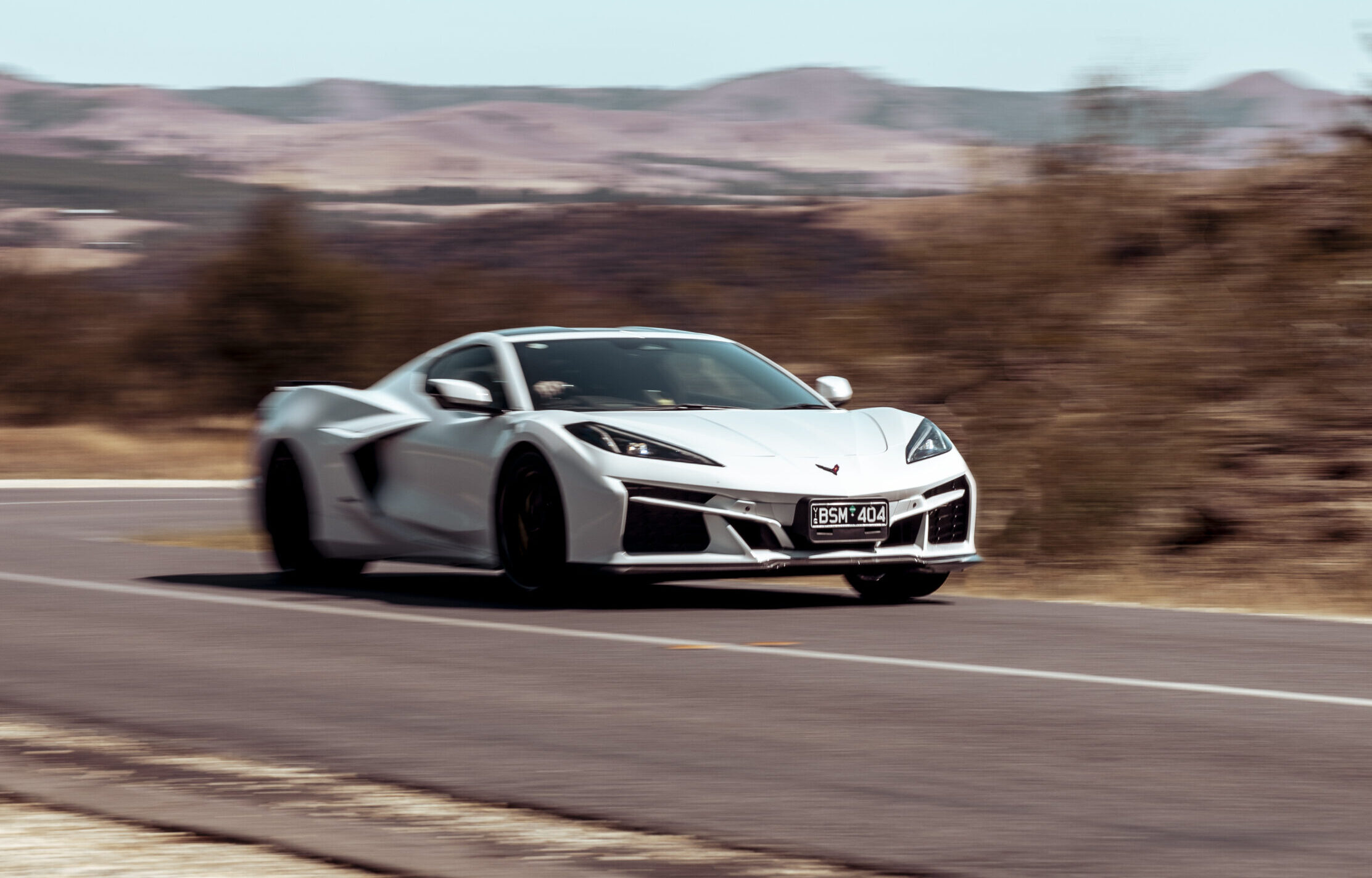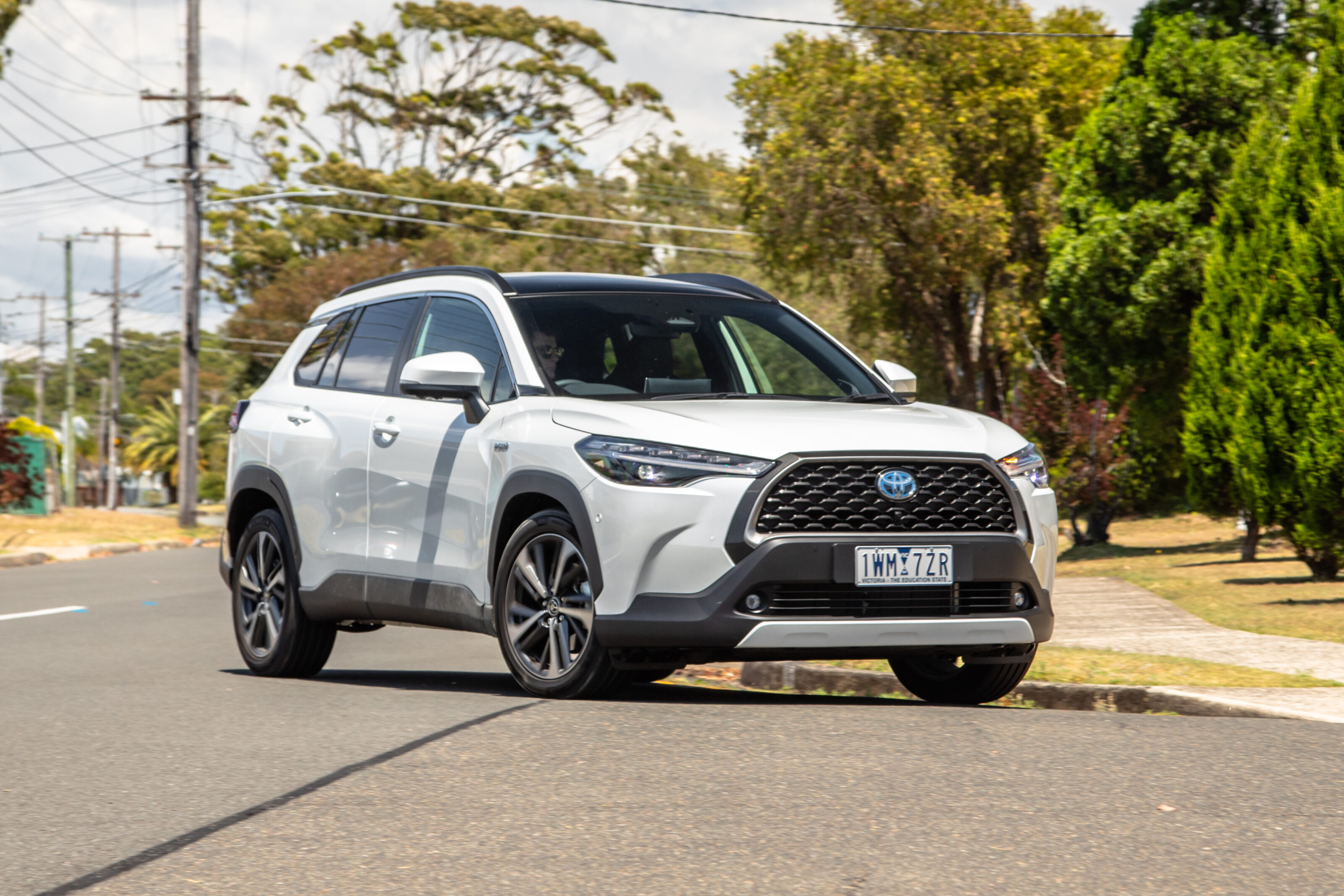
Score breakdown
Things we like
- Hybrid drivetrain
- Full of tech
- Nice to drive
Not so much
- Over-active reverse AEB
- Some tacky materials
- Rear seat space
No surprises, the Corolla Cross has been the instant smash-hit Toyota was expecting.
Any Toyota with ‘hybrid’ in the name is box-office gold – and if it hadn’t been popular, a lot of Toyota executives would have a lot of thinking to do.
Toyota told us the GX hybrid would be the most popular, and that seems to be about right. The company also thought far fewer people would buy the all-wheel drive hybrid than the front-wheel drive, an interesting contrast to the RAV4.
And really, when you’re at the price point of the front-wheel drive Corolla Cross Atmos hybrid, you’re probably thinking, wait, maybe I should get a RAV4? I’ve been thinking the same thing, so let’s have a look and see what you get for fifty-odd grand on the road.
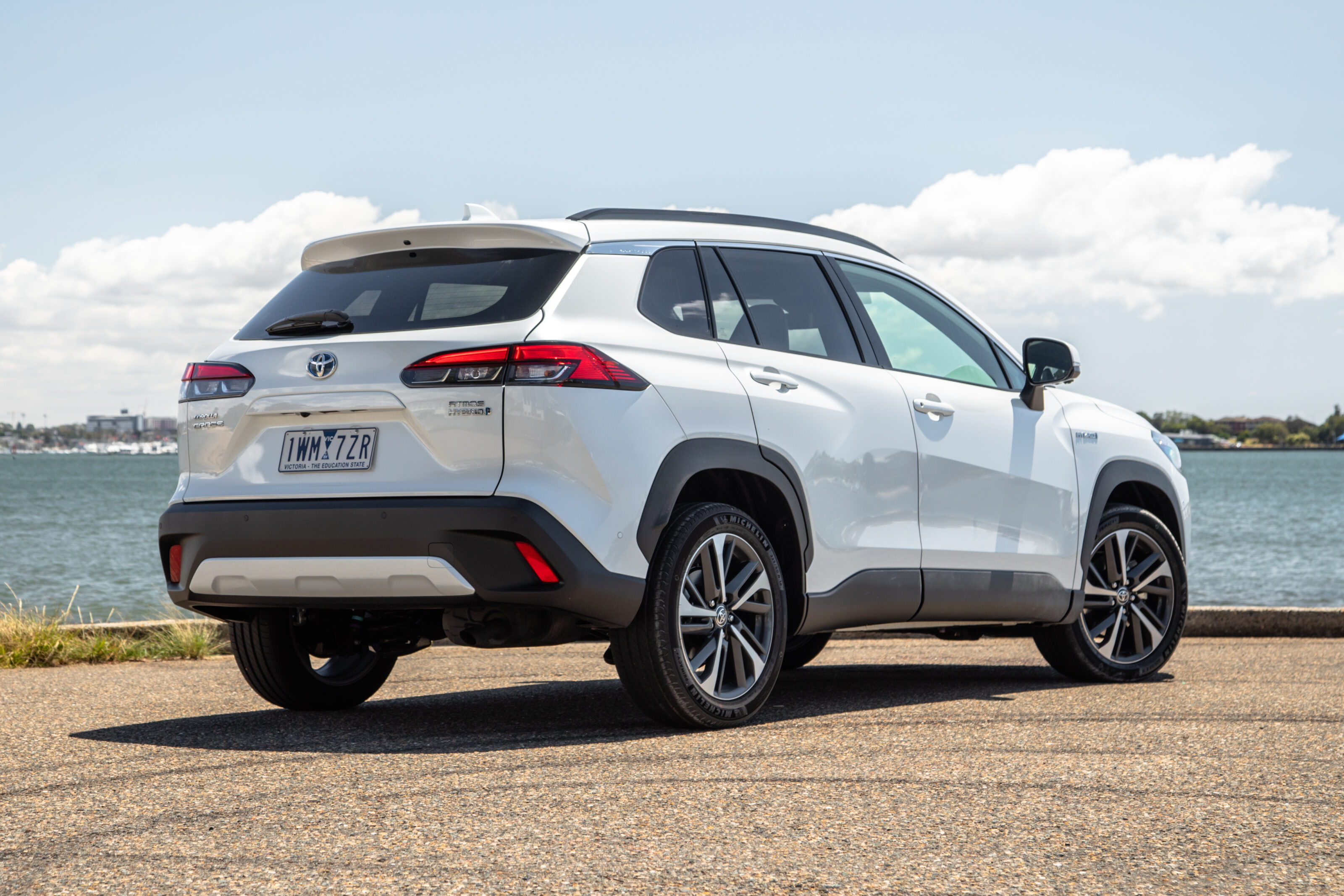
JUMP AHEAD
- How much is it, and what do you get?
- How do rivals compare on value?
- Interior comfort, space and storage
- What is it like to drive?
- How much fuel does it use?
- How safe is it?
- Warranty and running costs
- VERDICT
- Specifications
How much is it, and what do you get?
The Corolla Cross petrol range starts in the mid-thirties with a front-wheel drive petrol.
The GX is a decent amount of car for the money if you’re not fussy about how quickly you can go (because it’s not at all quick) or how many gadgets you have.
Up in the mid-forties, it’s quite a different proposition with lots of equipment, tech and extra safety gear.
For $46,060 before on-road costs ($3000 cheaper than the AWD) you get a front-drive Corolla Cross Atmos hybrid with:
| 2023 Toyota Corolla Cross Atmos FWD hybrid features | |
|---|---|
| 18-inch alloy wheels | Keyless entry and start |
| 9-speaker JBL-branded stereo | Multi-zone climate control |
| Auto LED headlights | Power-adjusted front seats with memory |
| Auto parking | Power tailgate |
| DAB+ digital radio | Reversing camera |
| Digital instrument panel | Sat-nav |
| Electrically operated rear door locks | Sunroof |
| Heated and folding rear-view mirrors | Tyre repair kit |
| Heated front seats | Wired Android Auto |
| Heated steering wheel | Wireless Apple CarPlay |
| Imitation leather interior | Wireless phone charging pad |
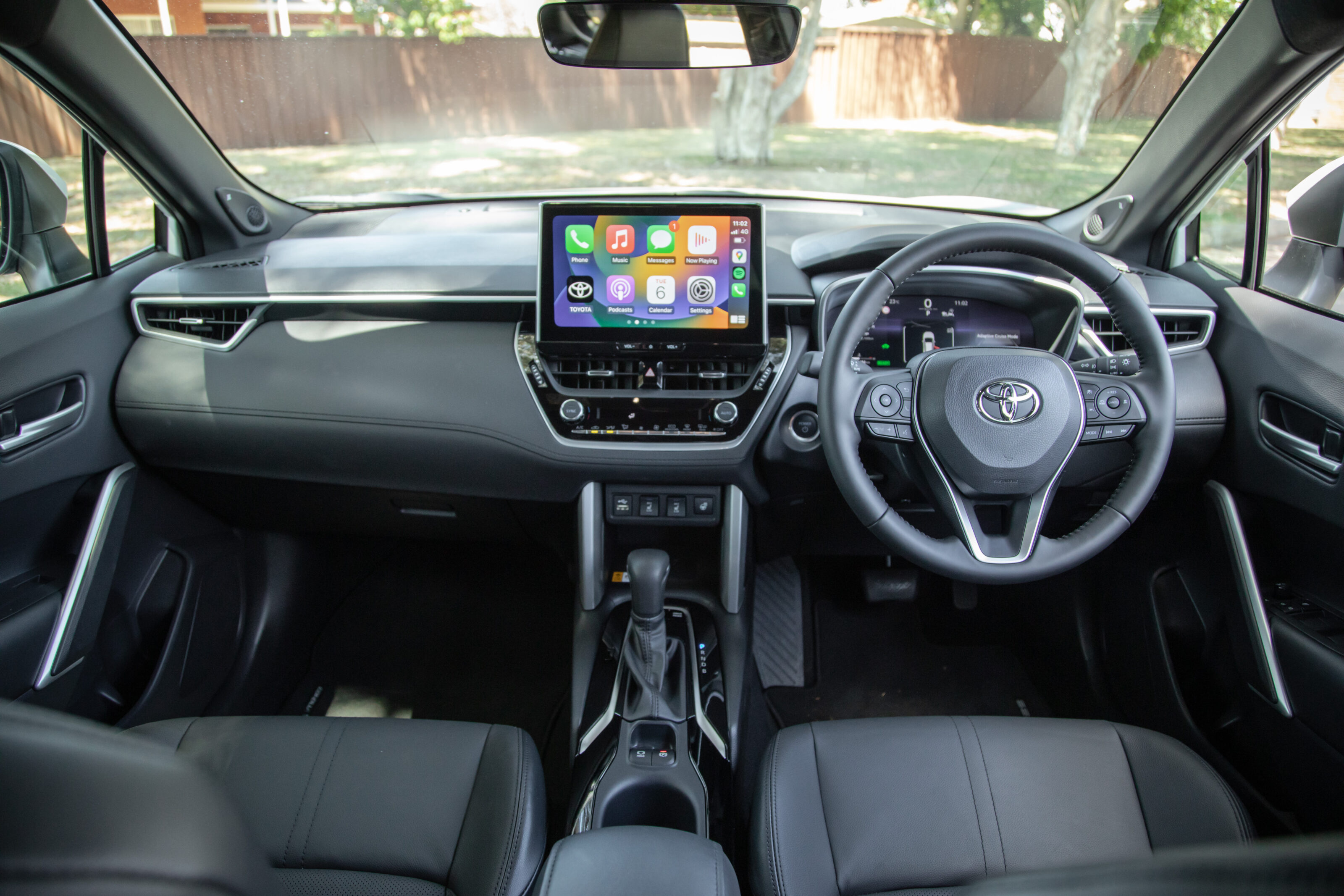
The Atmos picks up the ‘nanoe’ climate control system which allegedly filters out all sorts of stuff that we’d all rather not breathe. It also scores a more “premium” leather wrapping on the steering wheel, wireless charging, three extra speakers and a larger digital dashboard.
It shares the bigger 10.5-inch media screen with the GXL, sacrificing the volume dial for a pair of volume switches that just don’t cut it. What does cut it is the shiny new media system that replaces the awful junk Toyota shipped for years. It was unspeakably bad and this new system, while fiddly for some functions, looks way better and is way better, with sat-nav thrown in for free. Sadly not free is Toyota Connected Services.
Well, it is for the first twelve months but after that, they want to sting you a Disney Plus/Binge worth of dollars to maintain the full system. If you don’t want everything, you’ll be hit for roughly an Amazon Prime’s worth.
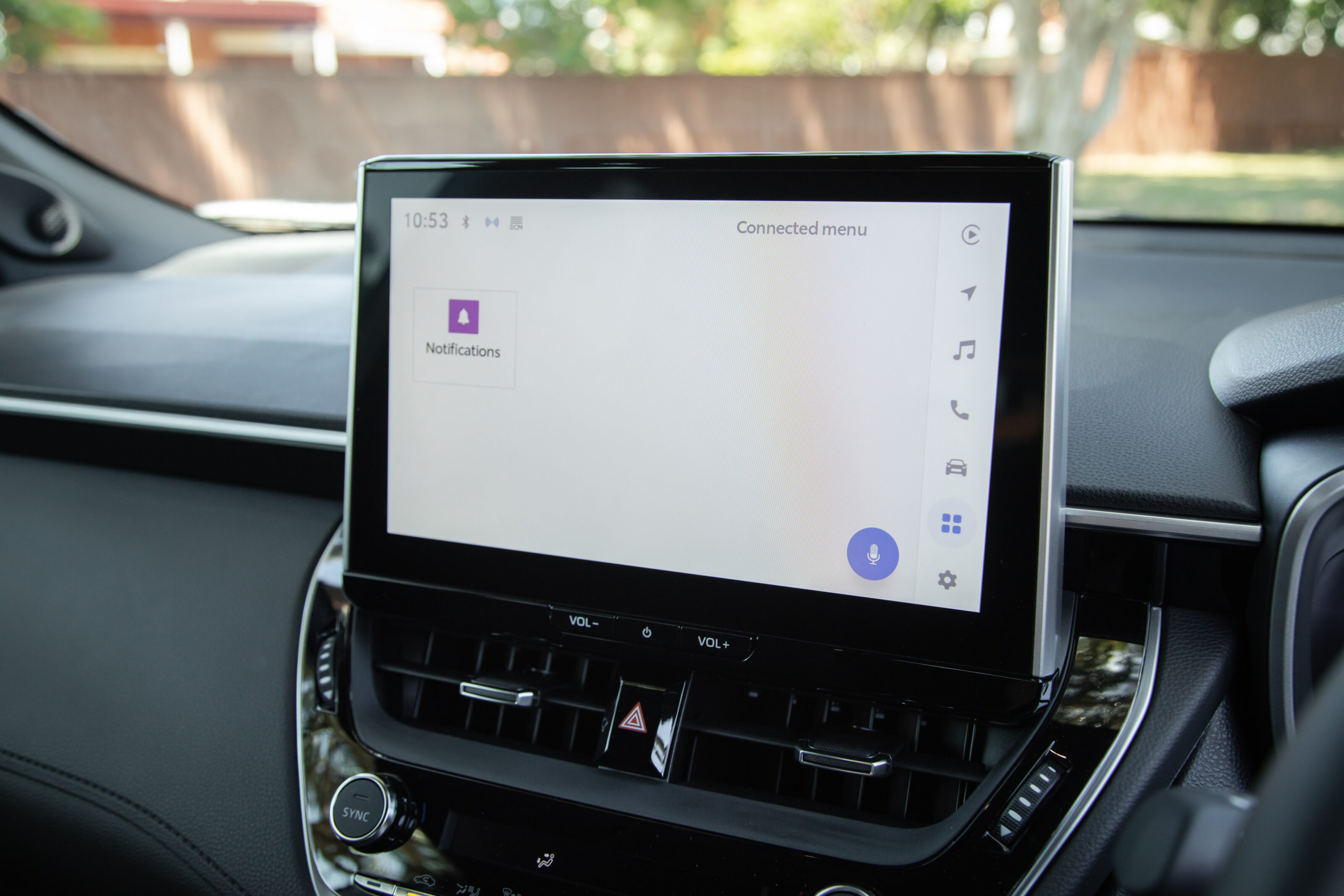
That’s $9.95 for the remote access features and another $12 for the advanced navigation features if you’re not into streaming services.
I can’t say I think any of the advanced features are must-haves (especially if you have a “mobile telephone”). Some folks do come to rely on them, so to whack you nearly $200 a year to keep them is a bit cruddy. I’d want this sort of thing covering the warranty period rather than just twelve months, but I’m sure Toyota would counter by saying “we’re giving buyers a choice”.
Some note title here
If you’re happy to go a size larger, check out our Best Medium SUVs test below. Watch for our Best Small SUVs test to come soon.
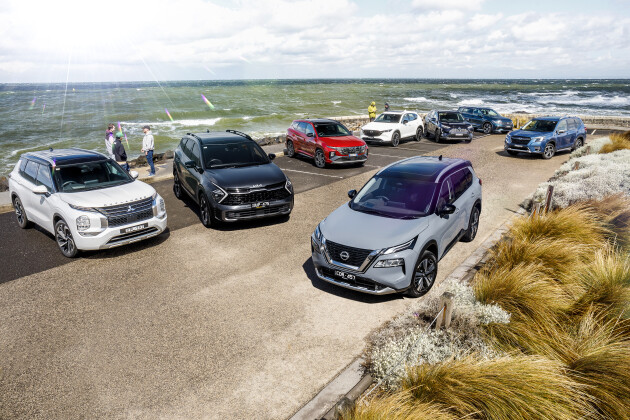
Medium SUV comparison: 2023 Mega Test
Thinking of buying a new mid-size SUV this year? We test eight of the best and most popular contenders to see where you should spend your money
How do rivals compare on value?
Honda’s HR-V is $47,000 drive-away for the top-spec L hybrid. That’s pretty sharp against the Atmos and it does have the better – if strictly four-seat – interior. But the HR-V is down on power and doesn’t quite have the same on-road vigour.
It shares the same five-year warranty length but is slightly cheaper to service at $199 per visit but maintenance intervals are shorter, with just a 10,000km allowance.
Kia’s Niro hybrid is a less well-known contender and, like the Honda, is not quite as good all-round but shines in some places. It has a longer, simpler-to-understand warranty, no subscription charges and I think it looks the business.
It remains baffling that Kia doesn’t do a Seltos hybrid because that would really give the Corolla Cross a run for its money. The Niro doesn’t really, at $44,380 for lower-spec S and $50,030 for the GT-Line (both before on-road costs).
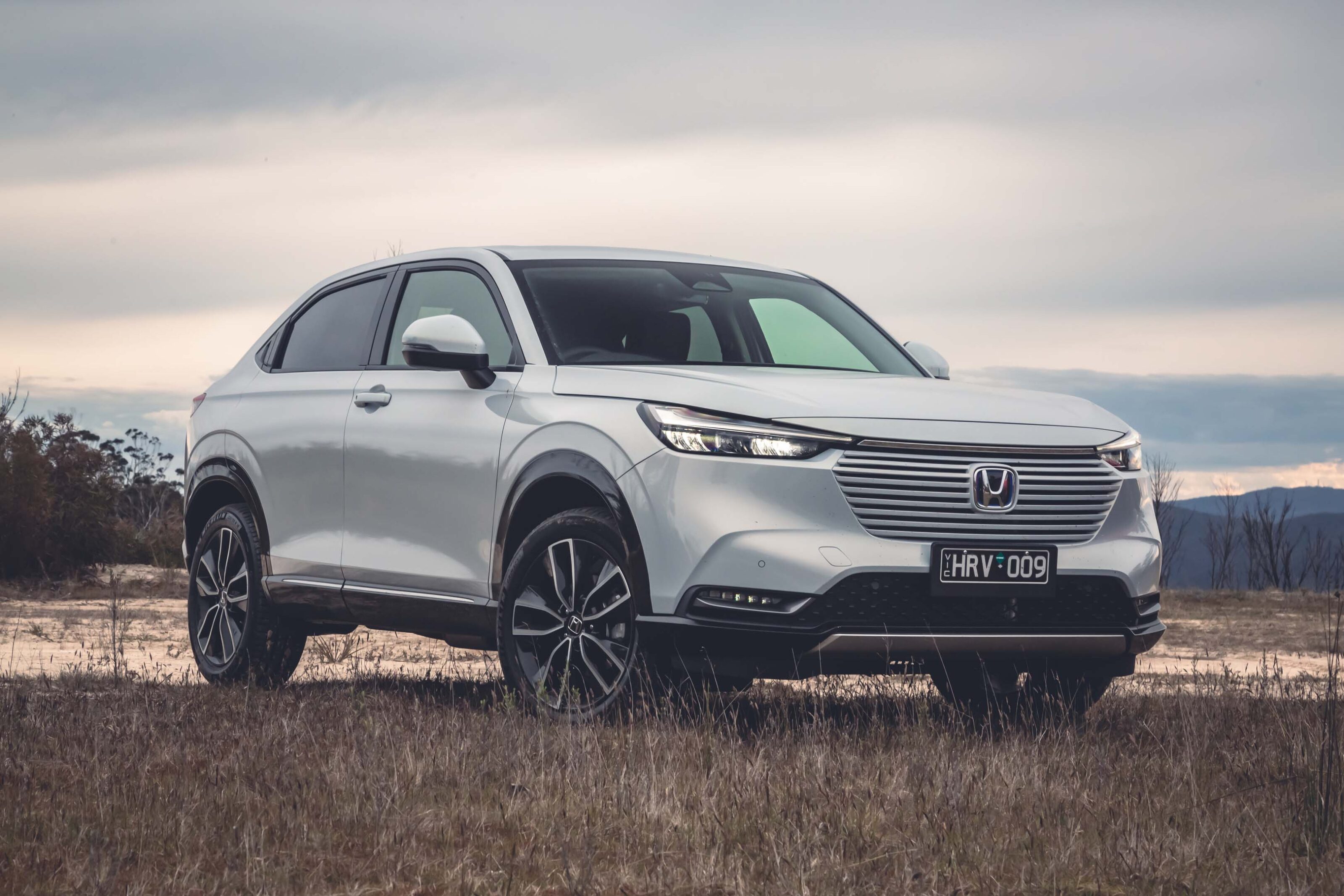
Interior comfort, space and storage
This segment of the market is frustrating in a few ways, because almost every car in it has odd specification choices.
In common with the Kia Seltos, only the top-grade Corolla Cross has a rear centre armrest. Call me crazy, but families who might like that feature don’t always have heaps of cash to splash and want somewhere to put the kids’ water/juice/bucket of Red Bull.
But once you’re past that quirk – which, as I say, won’t trouble you in the Atmos – the rear seat is quite a good place to be, with a good view out, plenty of foot room under the high-set front seats and a decent amount of knee and leg room.
Three across is doable if the middle person is small but as is the case on so many cars, it’s not the nicest place to sit. There are two USB-C connectors for rear occupants, along with air vents and bottle holders in the doors.
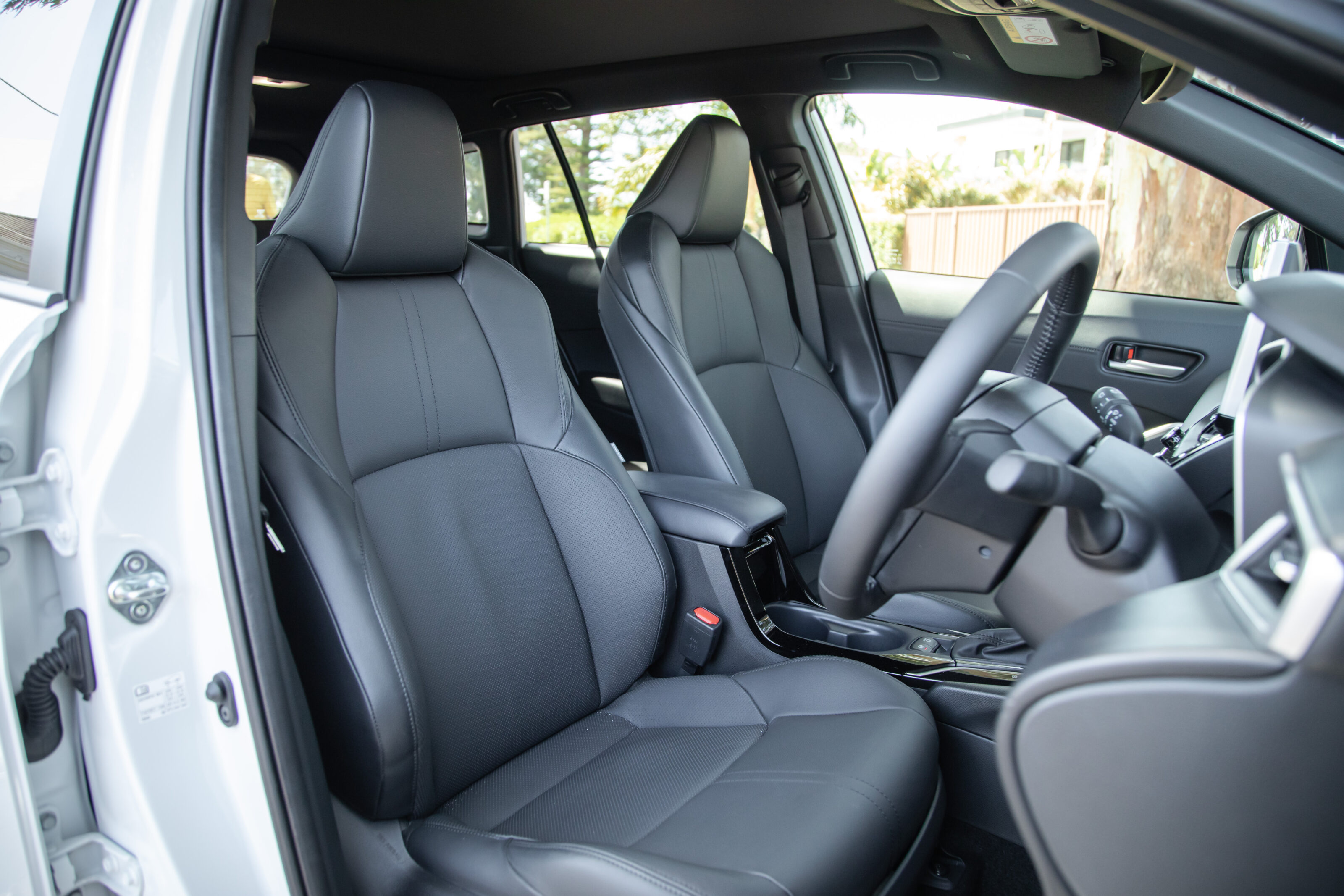
As with most other new Toyotas, the front seats are excellent. Comfortable in all the right places, my only criticism is that they’re set too high and you’re left with the feeling you’re sitting on the car rather than in it. But the seats are so comfortable you’ll forgive it unless you’re really tall.
There’s a wireless charging pad and USB-A socket beside it as well as a USB-C port in the console bin, which isn’t huge but rather handy. A pair of cup holders do the job in the console, too, and the doors each have good pockets and small bottle holders.
2023 Toyota Corolla Cross Hybrid boot space
The Corolla Cross’s boot space is down on some in the class, by about 30 litres. Sporting 390L, it misses the magic 400 mark by not much but as the years go by, fewer cars in this class have less than that number.
Still, it’s much better than a Corolla hatch.
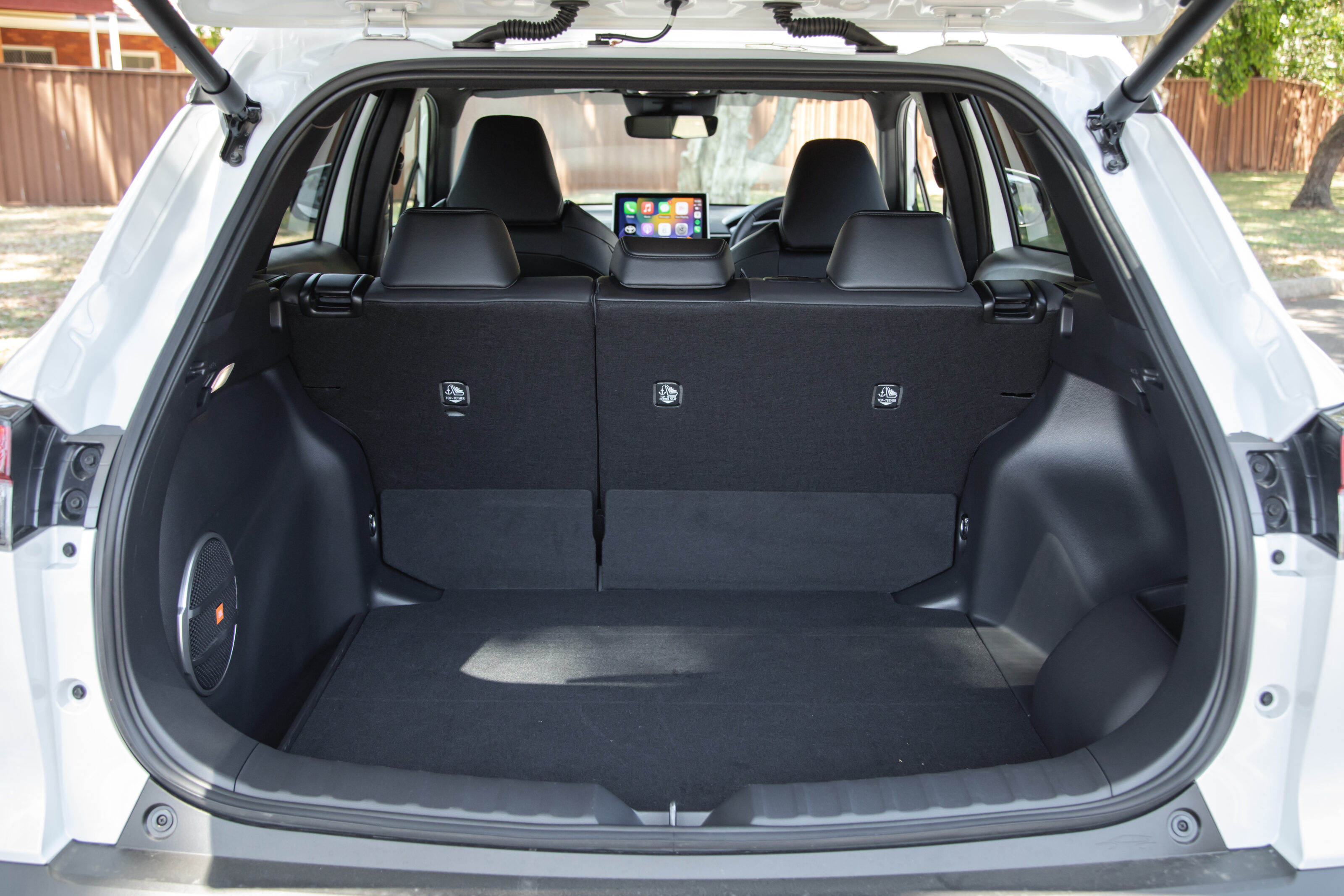
What is it like to drive?
The front-wheel drive Corolla Cross hybrids are an interesting mix. The chassis is basically the same as the base petrol-only car with a torsion beam rear end, even on the top-spec Atmos.
| 2023 Toyota Corolla Cross Atmos FWD hybrid drivetrain | |
|---|---|
| Drive | front-wheel |
| Power | 146kW @ 6000rpm |
| Torque | 190Nm @ 4400-5200rpm |
| Compression ratio | 14.0 : 1 |
| Electric motor | front |
| Electric power and torque | 83kW/206Nm |
| Combined power | 146kW |
| Combined torque | NA |
| Battery | lithiumi-ion |
| Transmission | continuously variable |
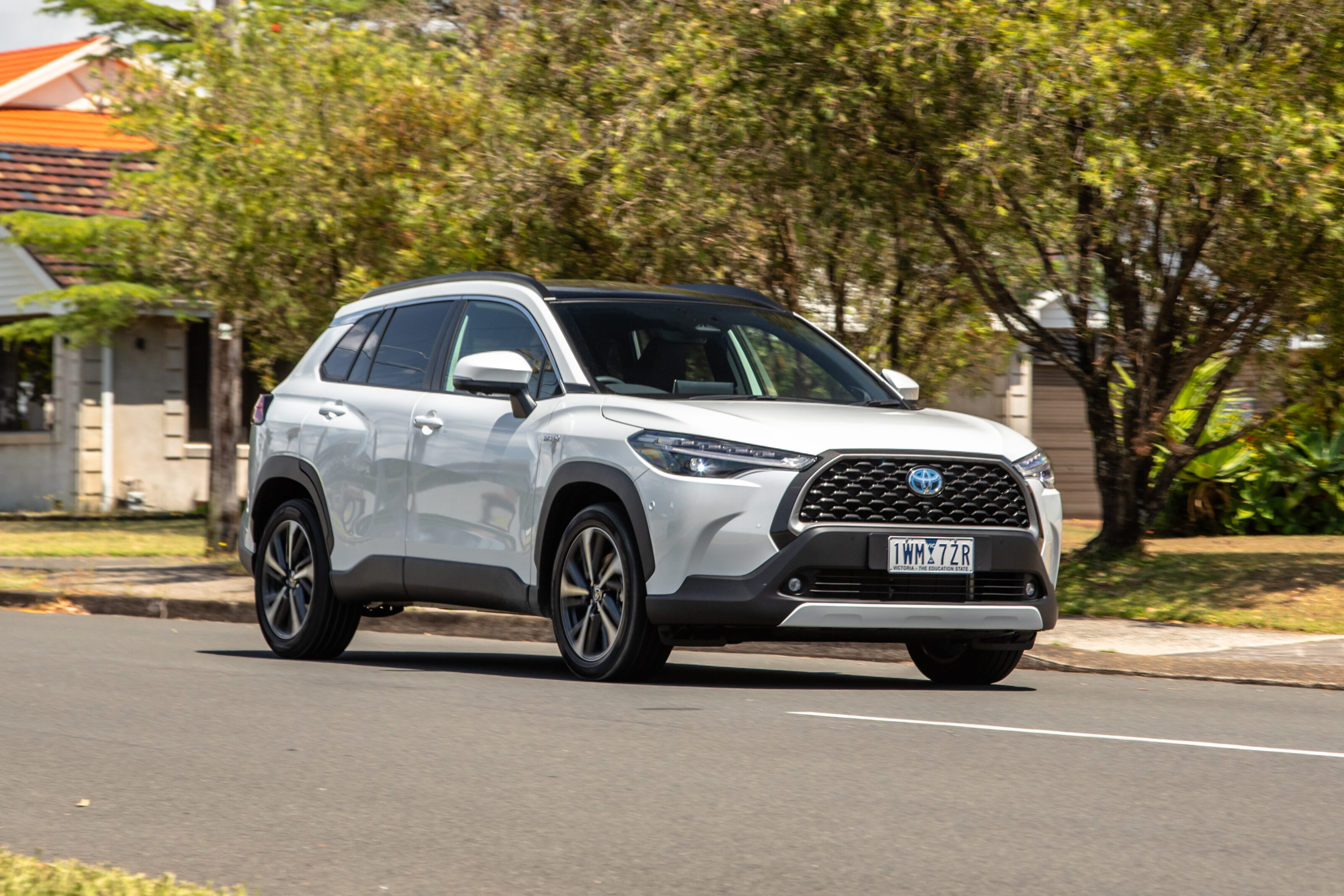
As with every other Toyota hybrid, the automatic continuously variable transmission (CVT) handles the power-to-wheel duties and, with all the development over the years, has become much more agreeable.
The front-wheel drive hybrid packs 146kW all up from its 112kW 2.0-litre internal combustion engine and 83kW electric motor. The ICE brings 190Nm to the electric motor’s 203Nm but there’s no reliable combined torque figure.
It’s probably quite a healthy figure because there’s plenty of power to spin the front wheels on greasy surfaces and it’ll even chirp out of a corner if you punch the throttle.
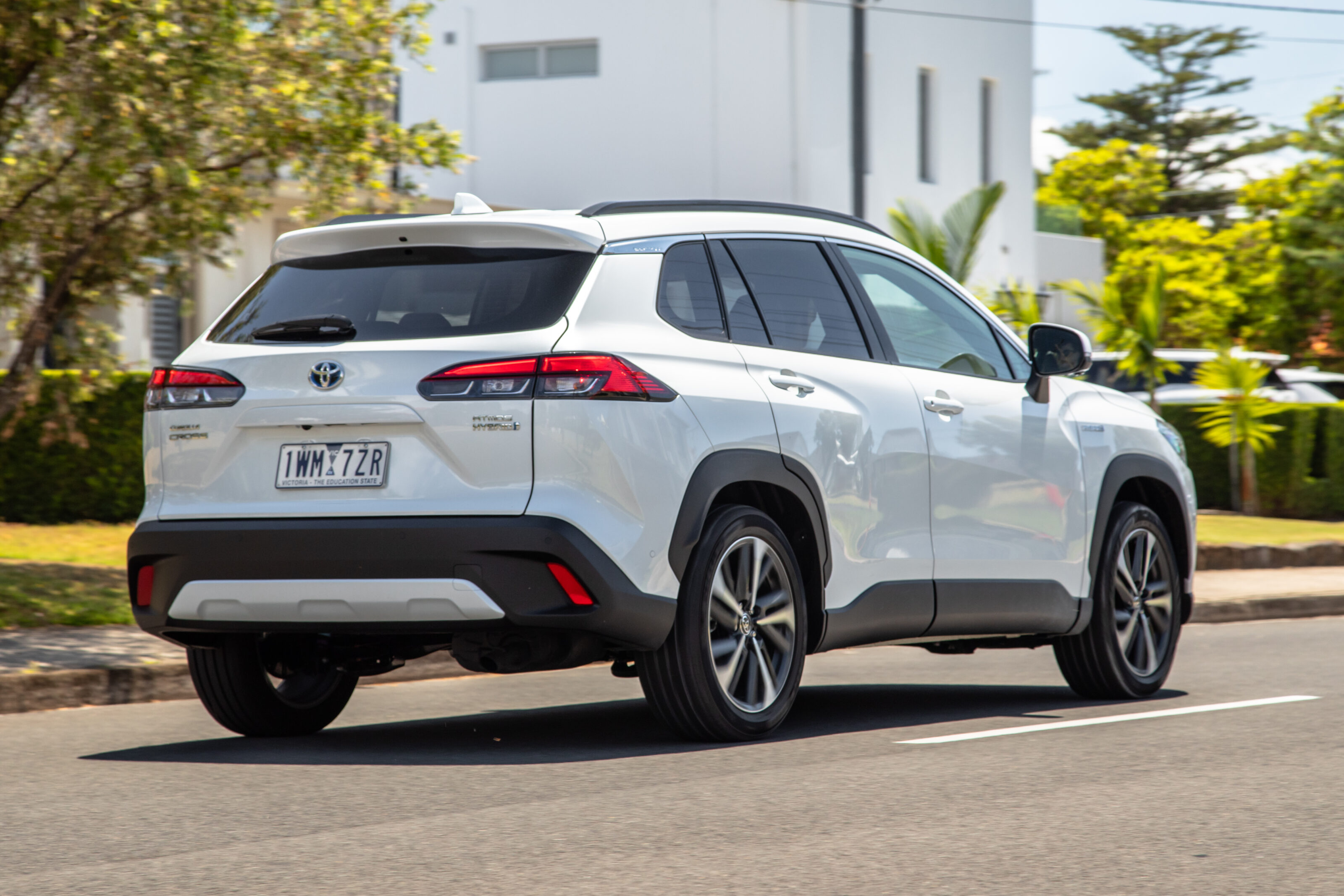
For front-seat passengers, the ride is pretty good and if that’s all you have to worry about, it’s a terrific car.
It also steers quite nicely as long as you’re not too enthusiastic about mashing the accelerator.
It’s really only enthusiastic drivers and/or rear-seat passengers who will notice the torsion beam suspension of the Atmos FWD. The rear will skip over those nasty rubber speed bumps and is a little less planted in fast cornering. While that’s hardly a core reason for buying a Corolla Cross, it’s worth knowing.
The ride is otherwise pretty composed, with only big bumps able to upset its relaxed demeanour.

How is it on fuel?
Toyota hybrids are famously easy on the gas and even with 1550kg to drag around, the ADR testing delivered a 4.3L/100km score on the combined cycle.
I got 5.2L/100km in a stinking humid week in Sydney with mostly suburban running and a few 80km/h runs thrown in, which I reckon is good going.
| Toyota Corolla Cross Atmos FWD fuel economy | |
|---|---|
| Fuel economy (ADR combined) | 4.3L/100km |
| Fuel economy (trip computer) | 5.2L/100km |
| Fuel economy (at the pump) | 5.2L/100km |
| Fuel type | 91 RON unleaded |
| Fuel tank capacity | 36 litres |
The Cross is tall and hardly an aerodynamic wonder, but you can easily cover about 680km between fills. If it’s fuel economy you’re really after, get a Corolla, save on the upfront cost and knock a litre off the real-world consumption.
Its mildly absurd 36-litre fuel tank is tolerable given the impressive return on fuel economy. The trip computer and the pump agree with my real-world week, which burnt fuel at 5.2L/100km.
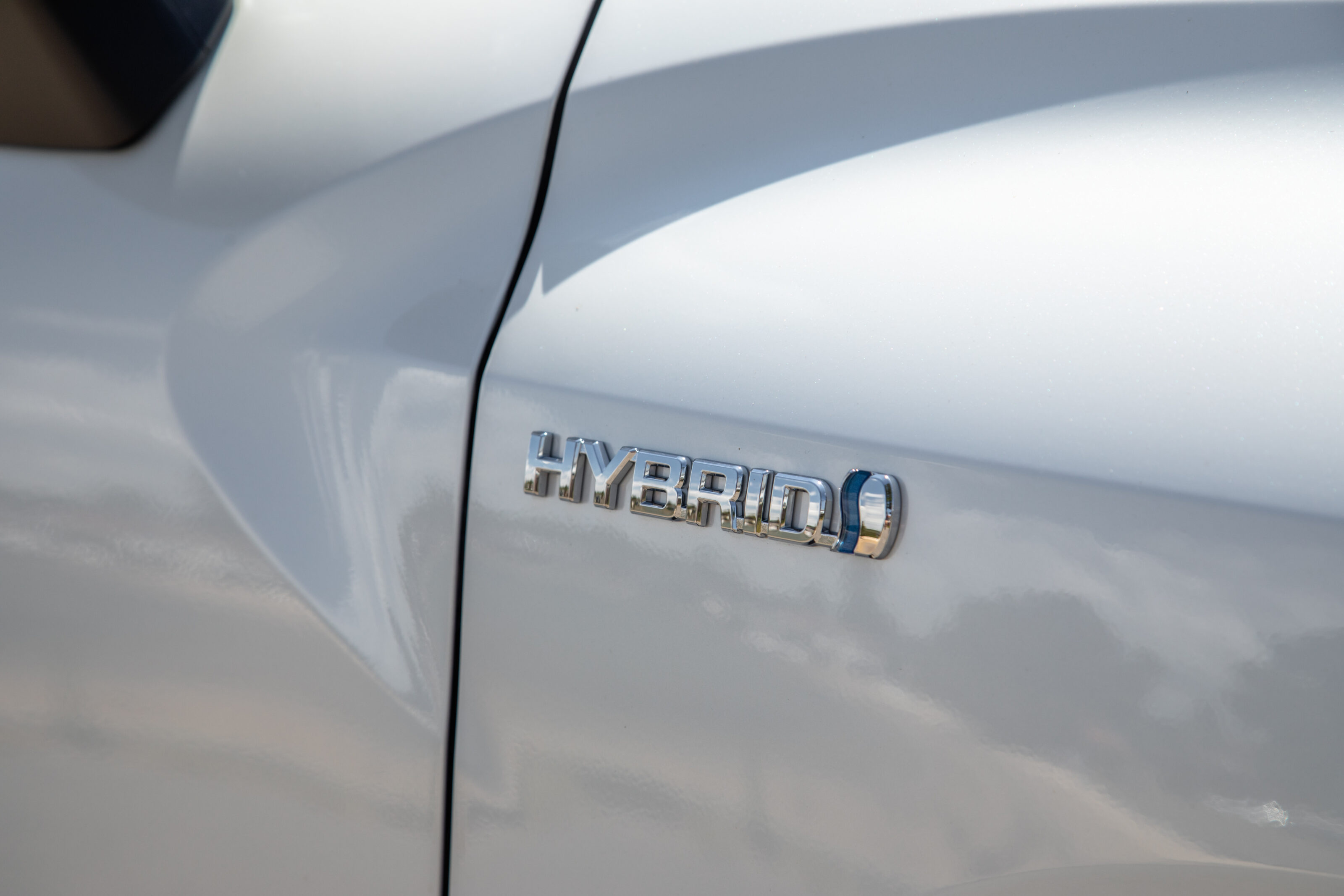
How safe is it?
The five-star ANCAP safety rating for the Corolla Cross results from a pretty healthy set of numbers across the entire range.
The Atmos only picks up a couple of bits and pieces over the GXL, which itself really only grabs the Parking Support Brake (PKSB) feature over the GX.
| 2023 Toyota Corolla Cross Atmos FWD hybrid safety features | |
|---|---|
| 8 airbags | ABS |
| Stability and traction controls | Forward AEB (high and low speed) |
| Forward collision warning | Reverse cross-traffic alert |
| Reverse AEB (low-speed) | Front cross-traffic alert |
| Lane departure warning | Lane-keep assist |
| Driver attention detection | Safe exit warning |
| Blind-spot monitoring | 360-degree cameras |
The forward auto emergency braking (AEB) features daytime pedestrian and cyclist detection as well as operating at city and highway speeds. The low-speed PKSB turned out to be a bit finicky, though.
A tall hedge lines the left side of our driveway and more than once when we tried to back out, the toys would go out of the pram. The car was convinced it was going to hit something solid and would jam on the brakes. That got real old real quick.
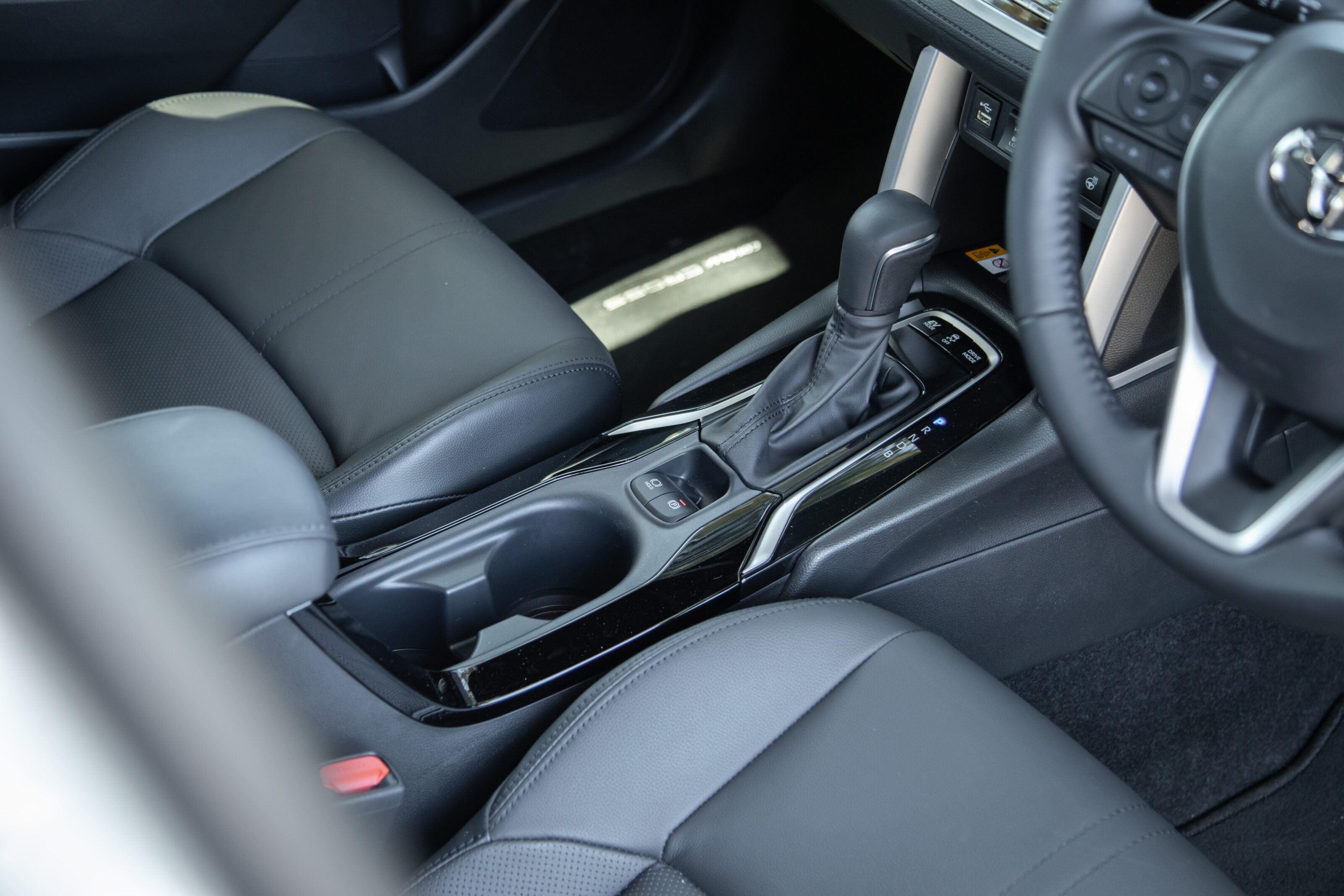
Ironically, moving across to the right and close enough to almost scrape the driver’s mirror down the side of the house, no drama. My wife has little patience for this kind of thing and mine wore thin by the end of the week.
The following week we had an all-wheel drive GXL which behaved far better, so it’s possible that the over-sensitive Atmos had something wrong with it, like a misaligned sensor, possibly on the left-hand side.
There are two ISOFIX points in the back row of seats and three top tether anchors.
Warranty and running costs
Toyota’s five-year, unlimited-kilometre warranty applies to the Corolla Cross, with the driveline warranty extending a further two years if you service at an official dealer.
Capped-price servicing applies for the first five services – which are spaced at 12 months/15,000km – and cost $250 each, $5 more than the hatch. That works out at $1250 over five services, which is pretty good going. Prices are up by $25 per service since launch.
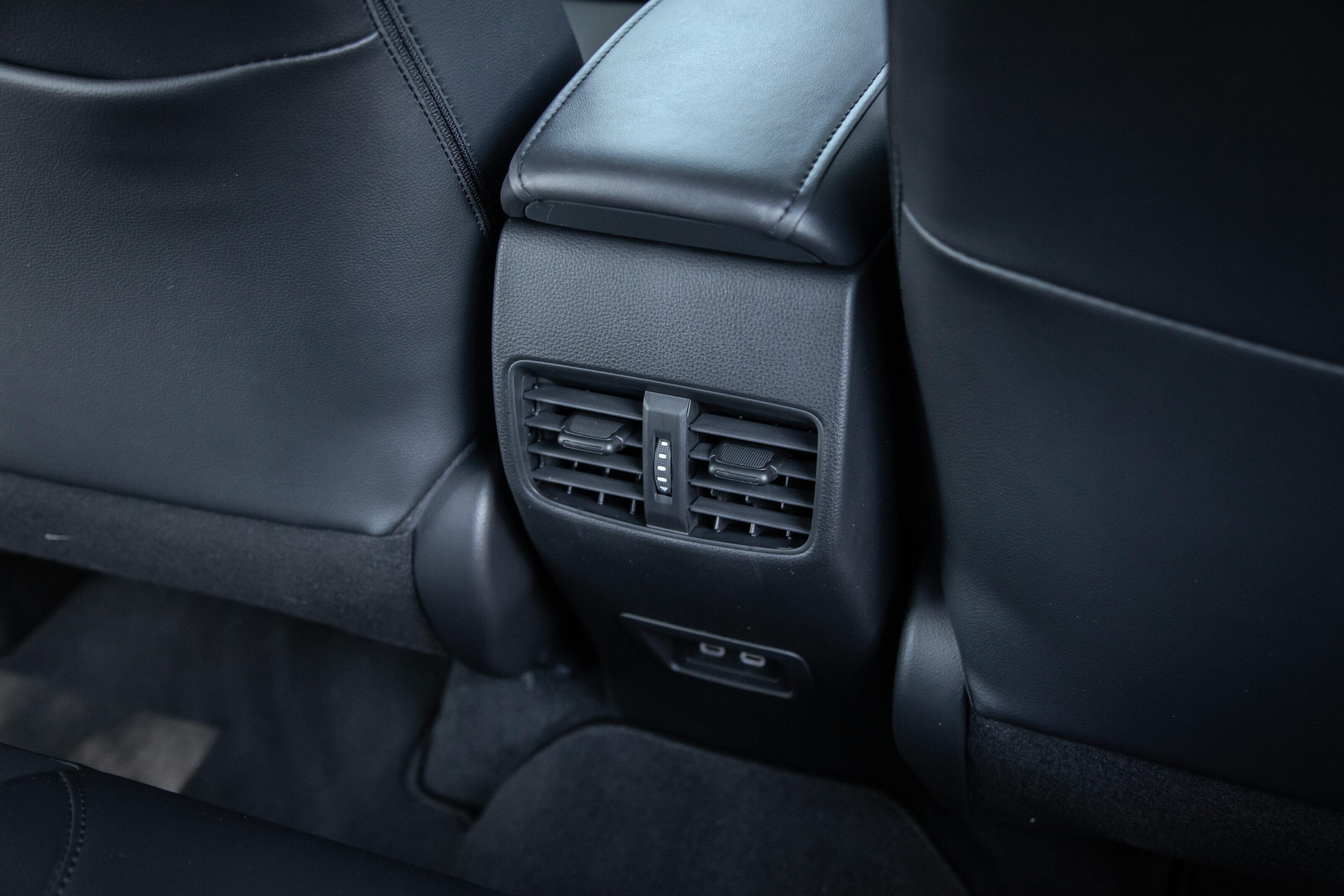
If you like the Toyota Connected Services features after the first 12 months, you’ll have to pay $9.95 per month for remote connectivity to locking, engine start and climate control. If you want to keep the fancy sat-nav features, that’s another $12 per month.
The feature set shrinks if you don’t pay but the sat-nav remains operable in a basic and very useable form.

VERDICT
One of the things I really appreciate about any hybrid Corolla Cross is that they’re not gutless, but they also deliver excellent fuel economy and refinement.
There’s a reason they’re flying out the door.
The Atmos, though, isn’t the one I’d have. Sure, it’s got lots of nice things, but not enough to justify the price increase and it really did have me looking at RAV4 prices and considering my theoretical position as a buyer. I’d prefer to step down to a GXL AWD or even save a few more bucks on a GXL FWD if I wasn’t fussed about the extra oomph (and traffic-jam-friendly EV capability).
Either way, you’re not making a mistake, though, which is the most Toyota thing ever.
| 2023 Toyota Corolla Cross Atmos FWD hybrid specifications | |
|---|---|
| Body | 5-door, 5-seat small SUV |
| Drive | front-wheel |
| Power | 146kW @ 6000rpm |
| Torque | 190Nm @ 4400-5200rpm |
| Compression ratio | 14.0 : 1 |
| Electric motor | front |
| Electric power and torque | 83kW/206Nm |
| Combined power | 146kW |
| Combined torque | NA |
| Battery | lithiumi-ion |
| Transmission | continuously variable |
| 0-100km/h | 7.5 seconds (claimed) |
| Fuel consumption | 4.3L/100km |
| Weight | 1550kg |
| Suspension | MacPherson struts front/trailing arms rear |
| L/W/H | 4460/1825/1620 |
| Wheelbase | 2640mm |
| Brakes | 305mm ventilated discs front/281m solid discs rear |
| Tyres | 225/50 R18 Bridgestone Alenza |
| Wheels | 18-inch alloy (space-saver spare) |
| Price | $46,050 + on-road costs |
Score breakdown
Things we like
- Hybrid drivetrain
- Full of tech
- Nice to drive
Not so much
- Over-active reverse AEB
- Some tacky materials
- Rear seat space
We recommend
-
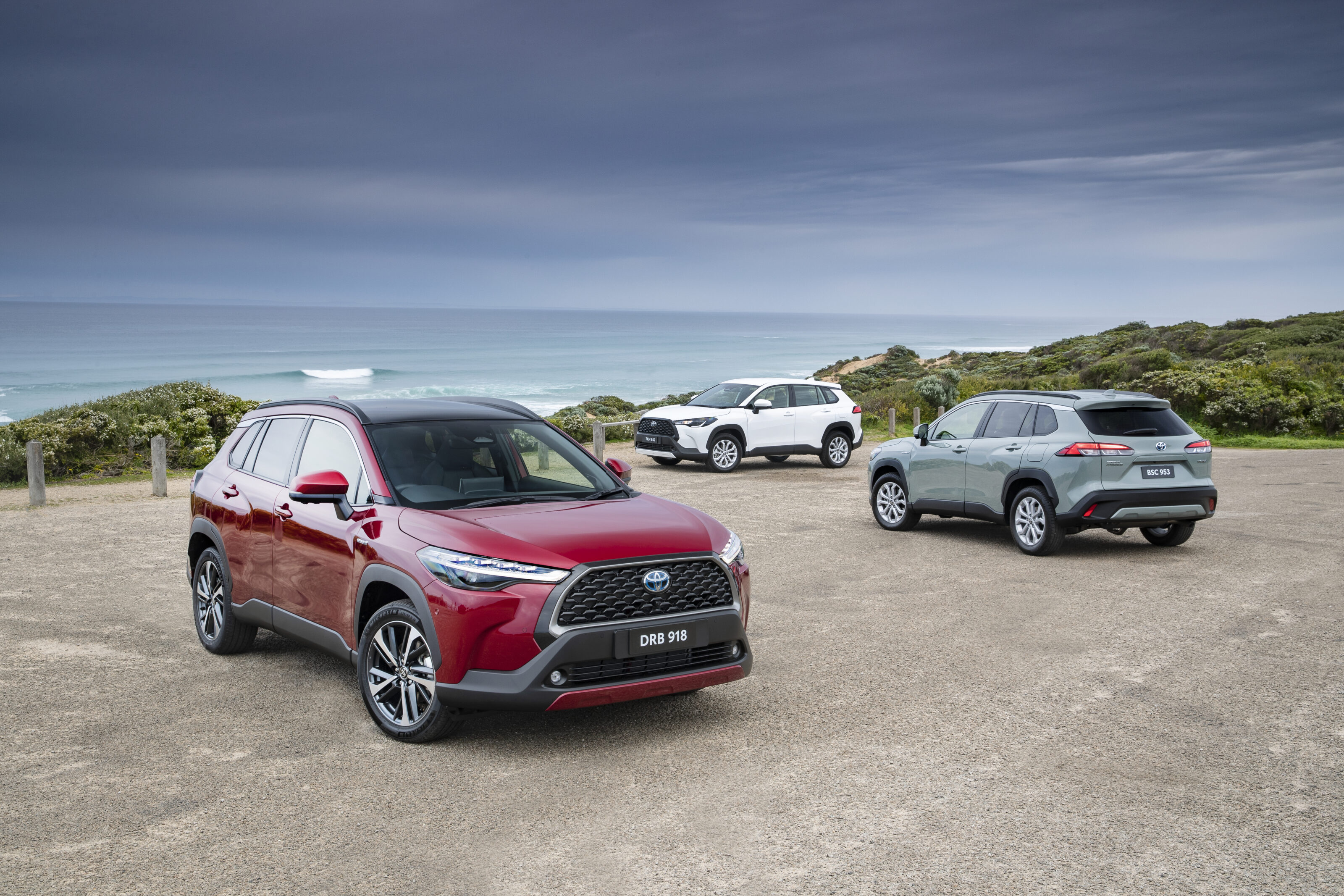 News
News2023 Toyota Corolla Cross pricing and features
Toyota's new small SUV, the Corolla Cross, has landed in Australia, slotting between the Yaris Cross and RAV4
-
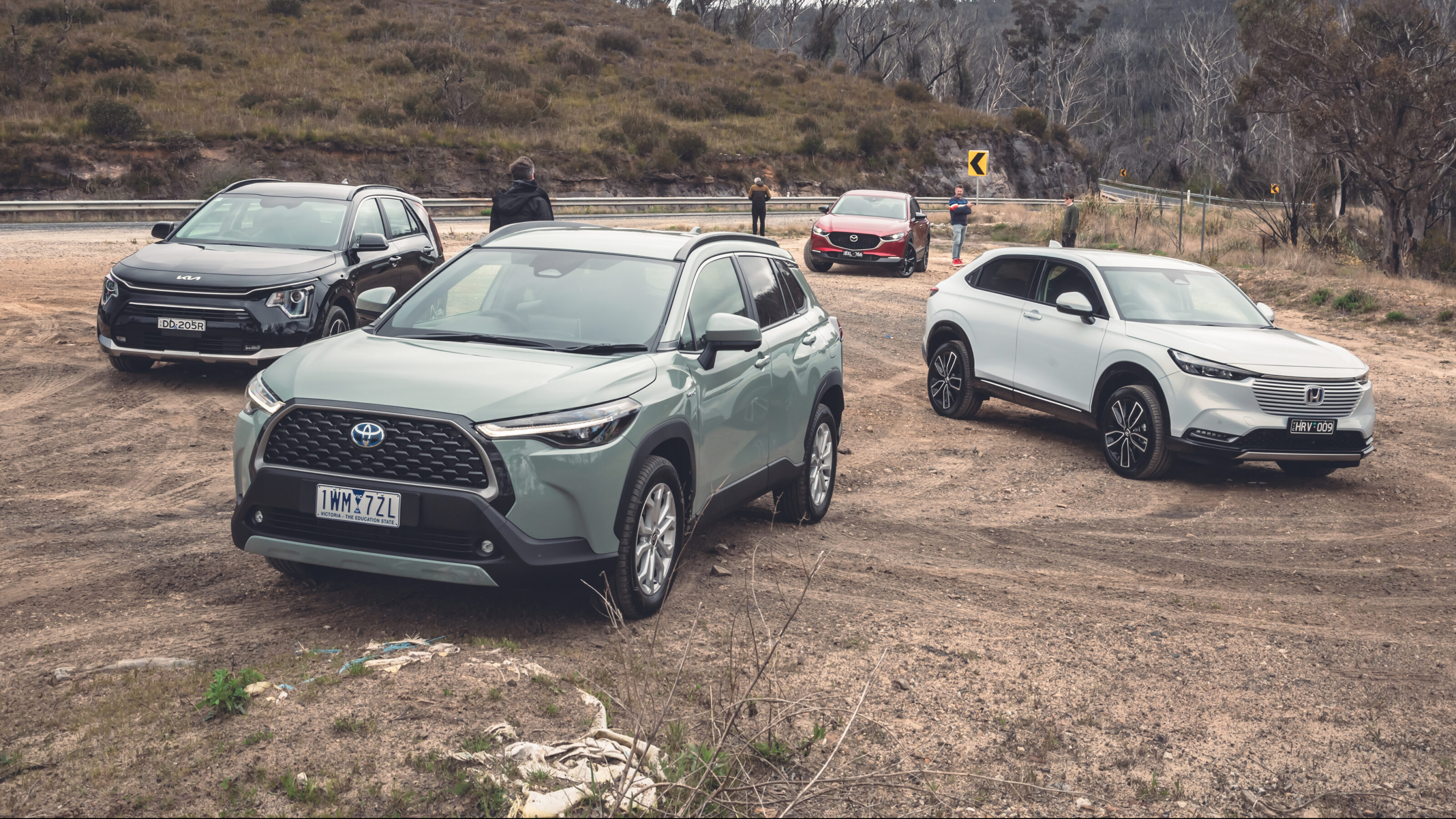 Comparisons
ComparisonsBest small hybrid SUV review: 2023 HR-V v Corolla Cross v Niro v CX-30 (petrol)
The increasingly important small SUV category has been crying out for new under-bonnet tech and better interior packaging. Are these four up to the task?
-
 News
News2025 New Car Calendar: All the new cars coming to Australia
Take a look at our list of what is expected to launch in Australia in 2025 – plus those we might not see locally just yet




